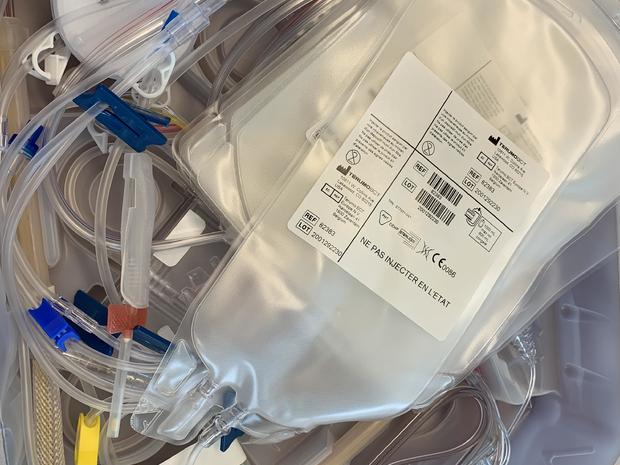Thousands of Lakewood residents have heightened cancer risk, EPA says
A medical equipment manufacturing and sterilization company in Lakewood, lauded for saving millions of lives with its technology, is now accused of risking other lives in the process, according to recent lawsuits.
The suits come following studies from the Environmental Protection Agency showing an elevated lifetime cancer risk for thousands of people living near the facility.
The Terumo Blood and Cell Technologies facility at the corner of Simms Street and Collins Avenue in Lakewood is facing lawsuits from several community members, who say they got sick with cancer because of Terumo's ethylene oxide emissions.
The Environmental Protection Agency and Colorado Department of Public Health and Environment, or CDPHE, say while the risk is small, there is a higher likelihood for someone living in the community to develop cancer due to ethylene oxide levels in the outdoor air, and that risk increases the longer someone lives there, the more hours they are exposed, and children may be more susceptible.
According to the EPA, there are approximately 1,900 children aged 17 or younger who live within a one mile radius of the facility, and 9,450 people total living in the same one mile radius.
While the Lakewood facility has had different owners over the decades, the factory has been up and running, manufacturing medical equipment and sterilizing it for more than 40 years.
The facility makes life saving blood donation supplies, and other medical tech, including blood devices that are used in some Colorado hospitals.
"Terumo Blood and Cell Technologies makes products that collect, separate and process blood and cells," a spokesperson for the company said. "These products are used in stem cell collections, blood donations, blood transfusions, plasma collections, and they enable cancer treatments."
Right now, the only Federal Drug Administration-approved way to sterilize many medical supplies is by using a gas known as ethylene oxide — or EtO — a gas the EPA says is carcinogenic to humans.
One community member's long battle with bone marrow cancer
Blake Darnell, 32, says he used to ride his bike at the bike park to the east of the facility just about every day as a child, but now he can barely walk.
In 2009, he was diagnosed with acute lymphoblastic leukemia, a cancer of the bone marrow.
"I was at work, and I just had this pain shooting through my left leg," Darnell recalled. "By the third day, by the time I got home from work, I could barely walk, and dad had to carry me out to the car, and we went to the hospital, and went in, and they drew blood, and said you have... cancer."
Darnell spent years in the hospital after his diagnosis, and eventually, his leg was amputated.
After more than a decade of fighting the disease, Darnell says his bones are deteriorating, and he's in constant pain.
"There's no cartilage in my bones, so they just grind together, just bone on bone, just disintegrating, chipping," Darnell said.
He rates his daily pain scale a nine out of 10.
"I got this tape that kind of helps, kind of feels like it holds the bones kinda from moving around," he said. "It doesn't help a whole lot, more than a lot of the other things I've tried, but still it just doesn't really stop it."
Before his diagnosis, Darnell had dreams of becoming a ski instructor, but after more than 20 surgeries, Darnell hasn't recovered enough to see those dreams through.
"I was kind of under the impression that... I was going to do the surgery and get back to my life," Darnell said. "Every time I got something fixed, something else happened. Just just seems like it's never ending, just every time I think I'm going to get my life back and start doing stuff again, just something else happens and you're right back to square one."
He said he was surprised in 2018 when he saw information online about the potential hazards of EtO.
He is one of several people who have filed suit against Terumo BCT, claiming the facility's EtO emissions are to blame for their cancer diagnoses.
He believes the company should have warning signs around the facility alerting community members to potential risks.
"I just know if there were signs when I went there that said, 'you're at risk of getting cancer if you ride your bike here,' I would not have rode my bike there," he said. "I'm sure 100 kids that have ended up there after me would have done the same thing."
EPA: Lifetime cancer risk for people living closest to Terumo is 600 in a million
The EPA's regulations on EtO emissions haven't changed since the 1990s. In 2018, the EPA released a study indicating EtO emissions can be much more dangerous than previously thought, finding there was a greater cancer risk for some Lakewood residents.
After that study, Terumo began implementing more controls to lower its emissions. EPA records show in 2016, the facility emitted 2,759 pounds of EtO, and by 2021, the facility only emitted 1,581 pounds.
But even after those new controls were put in place, the EPA released an updated study in 2022 finding community members living near the facility have a "lifetime cancer risk of 100 in 1 million," which "means that if 1 million people were exposed to this level of EtO in the air 24 hours a day for 70 years, 100 people would be expected to develop cancer from that exposure."
The study also found that among people living closest to the facility, there is an increased cancer risk level of 600 in 1 million.
EPA records show the average state lifetime cancer risk in Colorado is only 25 in 1 million.
"It's important for people to recognize that, you know, as we try to assess risk, in these worst case scenarios to understand the worst situation that it could be, but for most people, they don't live in the same house for 70 years, and we also aren't outside in the same place for 24 hours a day, seven days a week," says Dr. Kristy Richardson, State Toxicologist for the CDPHE. "We would expect that risk would be much lower."
CDPHE studied cancer rates in the area in 2018, and found 226 people had cancer there between the years 2000 to 2017, slightly higher than the expected number of 197.68, but the health department concluded those higher numbers were not "statistically significant," and many factors can increase someone's chances of having cancer, like lifestyle behaviors and genetic factors.
"We did not see that people in the community are actually experiencing higher rates of cancer than what we would expect across the state," said Dr. Richardson. "However, that study has some limitations, and we might not be able to identify that risk, especially because we're looking at so small of a community that's being exposed to ethylene oxide."
But state health records show in the census tract where the facility is located, the life expectancy is 70.7 years, nearly 10 years less than the state average life expectancy of 80.5.
"As the daughter of a terminal cancer patient, I know firsthand how devastating cancer is to individuals in their family," Richardson says. "I really empathize with people in this community hearing about risk and not only worrying about the cancer, but there's a lot of stress and anxiety that causes people too, and I want to acknowledge that that's really challenging for people in the community."
Richardson added the risk level in the community is "a slight elevation... and that risk would be greater the longer people live in that area as long as they're exposed to that ethylene oxide."
Previous air quality monitoring and the push for more in the future
"It's concerning," says Marianne Ortiz, the president of her Applewood Valley neighborhood association.
She says she and other community members living near the facility want to see more steps taken to ensure she and her neighbors are safe.
"We want Terumo to be a good neighbor, and to be transparent about any type of EtO that's in the air," Ortiz said. "We just want them to be honest, and we are hoping that they will help us to acquire monitors that will provide that transparency to the community."
Terumo and CDPHE conducted air quality monitoring in 2018.
While Terumo says EtO levels previously found around the facility in that 2018 testing "were generally similar to background concentrations in the state," state testing records show average EtO levels in and around Terumo were higher than average background levels measured in other Colorado communities before the company installed emissions controls in 2018.
After those controls were implemented, state records show average EtO levels measured on Terumo's property were still higher than average background levels in other areas of Colorado, and average levels found in areas near the facility were either at or slightly above overall average background levels measured from other areas of the state.
Asked about the results, Terumo said, "measurements collected in residential areas near the Terumo BCT facility both before and after Terumo voluntarily implemented additional controls are within the range of 'background' measurements that have been collected by CDPHE, U.S. EPA and others, in Colorado and the U.S. Background measurements of EtO around Jefferson County range up to 1.05 ug/m3."
Terumo also added, "all of the measurements collected by CDPHE, both at Terumo's facility and in the surrounding residential areas, are more than 1,000 times lower than where short-term and long-term health effects are expected to be observed, based on standards set by OSHA, CDC, EPA and other agencies for health-protective decision making."
So far, no new outdoor air quality monitoring plans are in the works, but Terumo says it will conduct more air quality monitoring if required by the state or EPA.
As someone who works from home, Ortiz says she's worried about being exposed to the EtO emissions 24 hours a day.
"There are quite a few members of the community that have experienced cancer," Ortiz said.
Terumo's response: "Our operations are not harming residents"
While Terumo declined multiple requests for an on-camera interview, a spokesperson for Terumo says, "we are confident our operations are not harming residents near our Lakewood facility."
The spokesperson emphasized the EPA's studies do not prove a causal link for any cancer diagnoses, writing, "we are not aware of any scientific study that suggests a link between the very low level of exposure to EtO that anyone in our neighborhood may have been exposed to from our facility and cancer (or any other disease)."
Terumo also says it is planning to install a more sophisticated system this summer that will reduce its EtO emissions by 70%.
Dr. Richardson with CDPHE says once those controls are implemented, her team will conduct additional analyses to see how the changes might affect health risk levels.
"After those additional controls come in, we'll work with EPA to better understand how that might change modeling," Richardson said. "We also will then have the ability to go out and do additional measurements to better understand what those changes might mean for people living in the area."
A spokesperson for Terumo said the company cannot comment on specifics to the lawsuits filed against the company, but offered more written statements, which read in part: "we are committed to bringing life-saving treatments to patients around the world and have heartfelt compassion for those struggling with cancer, leukemia, and other diseases... we actively work with local, state and federal agencies to continue to meet and exceed strict standards designed by these agencies to protect public health and the environment."
New EtO regulations on the horizon
While that takes place, the EPA is evaluating possible regulation changes to further reduce allowed EtO emissions at sterilization facilities nationwide. Click here for a map of all of the facilities across the country that emit EtO.
Kurt Zaner, Darnell's attorney, says it's a move that should have been made years ago.
"I believe the EPA has been behind the ball on this for a very long time," Zaner said. "The EPA — like all government — moves very slowly, and so they have had intentions to regulate EtO, ethylene oxide, they've had intentions to create regulations, but they haven't moved fast enough, and they're finally recognizing that, and they've now fast tracked ethylene oxide as a toxin... and start regulating it more more strictly, but the problem is a lot of the damage has been done."
He says recent lawsuits against other medical sterilization facilities emitting EtO in other states have been successful.
"It's very frustrating to see that injured people need lawyers like myself, to affect change, that corporations aren't taking responsibility," Zaner said.
Zaner says companies have known about the potential hazards for years, long before the EPA's risk assessment in 2018. Some studies published in the early 2000s shows cancer risks among people who worked at medical sterilization facilities — including a slightly higher prevalence of bone cancer, like what Darnell has.
Meanwhile, Darnell says he hopes his lawsuit will inspire change in Colorado.
"So, if there's a kid that's right at that park, he doesn't have to go through the hell that I've gone through," Darnell said. "So today's kid doesn't have to have his life ruined."
Alternative methods in the works?
Experts in the medical sterilization industry tell CBS News Colorado the FDA is looking at other options for alternative methods to sterilizing medical supplies, but right now, industry experts say EtO is the most efficient and effective method, because you can sterilize in large quantities, when the supplies are already boxed up and ready to ship.
It could be at least another five years before any other method is approved, and in the meantime, industry leaders say they think their time is best spent by creating ways to use EtO with less emissions.










